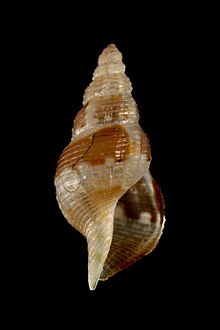Tritonoturris lifouana is a species of sea snail, a marine gastropod mollusk in the family Raphitomidae.[1]
| Tritonoturris lifouana | |
|---|---|

| |
| Shell of Tritonoturris lifouana (specimen at MNHN, Paris) | |
| Scientific classification | |
| Domain: | Eukaryota |
| Kingdom: | Animalia |
| Phylum: | Mollusca |
| Class: | Gastropoda |
| Subclass: | Caenogastropoda |
| Order: | Neogastropoda |
| Superfamily: | Conoidea |
| Family: | Raphitomidae |
| Genus: | Tritonoturris |
| Species: | T. lifouana
|
| Binomial name | |
| Tritonoturris lifouana (Hervier, 1897)
| |
| Synonyms[1] | |
|
Daphnella lifouana Hervier, 1897 (original combination) | |
Description
editTritonoturris lifouana is a small marine gastropod belonging to the Raphitomidae family. This family is characterized by its elongate and slender shells, which are typically ornate with axial ribs and spiral cords.
Shell Morphology: The shell of *Tritonoturris lifouana* is generally elongated with a high spire and a narrow, tapered body. The surface is often marked with fine spiral grooves and ribs, providing texture and complexity to its appearance.
Size: Shell length varies but is generally between 10 to 20 millimeters, fitting within the smaller spectrum of marine gastropods.
Coloration: The shell’s coloration can range from pale cream to darker brown hues, often with patterns or bands that may serve as camouflage in its natural environment.
Aperture: The aperture (shell opening) is small and elongate, leading to a short siphonal canal typical of many raphitomids.
Distribution:
Tritonoturris lifouana is endemic to the waters around Lifou Island in the Loyalty Islands, New Caledonia, in the southwestern Pacific Ocean. Its distribution may be limited to this region, making it an important species for local marine biodiversity.
Habitat:
This species typically inhabits deeper marine environments, often associated with coral reefs, rocky substrates, or sandy-muddy bottoms. These habitats provide the necessary resources and shelter for the snail to hunt and avoid predators.
Behavior and Ecology:
Tritonoturris lifouana is likely a carnivorous predator, as are most members of the Raphitomidae family. It preys on smaller marine invertebrates, using a specialized radula (a toothed, chitinous ribbon used for feeding) to capture and consume its prey. The species’ behavior and interactions within its ecosystem contribute to the complexity and balance of its marine environment.
Reproduction:
Like other gastropods, Tritonoturris lifouana likely follows a typical reproductive cycle involving the laying of eggs, which develop into free-swimming larvae before settling into their adult forms. Specific details on its reproduction are not well-documented but can be inferred from closely related species.
Conservation Status:
Currently, Tritonoturris lifouana does not have an assessed conservation status from major organizations such as the IUCN. However, its habitat, like many marine environments, may be vulnerable to threats such as pollution, habitat destruction, and climate change.
Significance and Research:
Tritonoturris lifouana is significant to malacologists and researchers studying marine biodiversity, especially within the region of New Caledonia. It adds to the understanding of gastropod diversity and the ecological roles of small predatory snails in coral reef and deep-sea ecosystems.
Distribution
editThis marine species occurs off the Loyalty Islands and Papua New Guinea.
References
edit- ^ a b MolluscaBase eds. (2020). MolluscaBase. Tritonoturris lifouana (Hervier, 1897). Accessed through: World Register of Marine Species at: http://www.marinespecies.org/aphia.php?p=taxdetails&id=1031280 on 2020-04-12
- Sysoev, A.V. (2008) Turridae. In Poppe, G. T. (Ed.) Philippine Marine Mollusks. Volume II. ConchBooks, Hackenheim, Germany, pp. 732–815. NIZT 682
External links
edit- Hervier J. (1897 ["1896"]). Descriptions d'espèces nouvelles de l'Archipel de la Nouvelle-Calédonie. Journal de Conchyliologie. 44: 138-151
- Gastropods.com: Daphnella lifouana
- Tucker, J.K. (2004). "Catalog of recent and fossil turrids (Mollusca: Gastropoda)" (PDF). Zootaxa. 682: 1–1295. doi:10.11646/zootaxa.682.1.1.